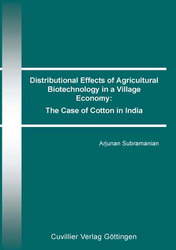| Areas | |
|---|---|
| Serie de libros (96) |
1378
|
| Nachhaltigkeit |
3
|
| Gesundheitswesen |
1
|
| Letra |
2363
|
| Ciencias Naturales |
5406
|
| Matemática | 229 |
| Informática | 319 |
| Física | 980 |
| Química | 1363 |
| Geociencias | 131 |
| Medicina humana | 243 |
| Estomatología | 10 |
| Veterinaria | 108 |
| Farmacia | 147 |
| Biología | 835 |
| Bioquímica, biología molecular, tecnología genética | 121 |
| Biofísica | 25 |
| Nutrición | 45 |
| Agricultura | 1004 |
| Silvicultura | 201 |
| Horticultura | 20 |
| Ecología y conservación de la tierra | 148 |
| Ciencias Ingeniería |
1791
|
| General |
98
|
|
Leitlinien Unfallchirurgie
5. Auflage bestellen |
|
Erweiterte Suche
Distributional Effects of Agricultural Biotechnology in a Village Economy: The Case of Cotton in India (Tienda española)
Arjunan Subramanian (Autor)Previo
Indice, Datei (28 KB)
Lectura de prueba, Datei (58 KB)
Despite the steady growth of the scientific literature on agricultural biotechnology, little systematic attempt has been made at a comprehensive examination of issues related to the impact of this technology on the level and composition of output and employment. This study examines the economy-wide effects of the most widely used and adopted transgenic crop technology in the developing world, namely insect-resistant Bt cotton. It presents a unique and detailed village-wide social accounting matrix (SAM) for India using data set collected through a census survey in a single village Kanzara. Given this framework, a micro-SAM multiplier model is formulated to examine and simulate the impact of alternative technological choices on household income distribution. The gains from adoption of transgenic cotton also depend on the nature of markets, the level of rural infrastructure and the price at which the output is sold. Therefore, beyond the SAM approach, this study also examines the interlocked village markets more closely.
| ISBN-10 (Impresion) | 3867273197 |
| ISBN-13 (Impresion) | 9783867273190 |
| ISBN-13 (E-Book) | 9783736923195 |
| Formato | A5 |
| Idioma | Inglés |
| Numero de paginas | 214 |
| Edicion | 1 |
| Volumen | 0 |
| Lugar de publicacion | Göttingen |
| Lugar de la disertacion | Hohenheim |
| Fecha de publicacion | 01.08.2007 |
| Clasificacion simple | Tesis doctoral |
| Area |
Agricultura
|








